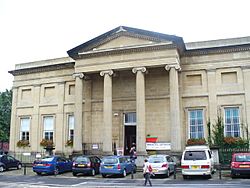Swansea Museum facts for kids
 |
|
| Lua error in Module:Location_map at line 420: attempt to index field 'wikibase' (a nil value). | |
| Location | Swansea, Wales |
|---|---|
| Type | Local history, transportation |
The Swansea Museum is a super cool place in Swansea, Wales, UK. It's actually the oldest museum in all of Wales! It was started way back in 1841 by a group called the Royal Institution of South Wales. They wanted a special place to keep their amazing collections and help people learn new things.
Contents
History of Swansea Museum
Swansea Museum first opened its doors in 1841. It was created by the Royal Institution of South Wales (RISW). This group loved art and science, and they wanted a special building for their collections. The museum building itself is very old and beautiful. It was built in a classic style called neo-classical.
In 1990, the local government, the City and County of Swansea Council, took over looking after the museum. This helped make sure the museum would continue to be a great place for everyone.
The museum faced some challenges, but the Swansea City Council stepped in to save it in 1996. Today, Swansea Museum is free to visit! It has six different galleries with all sorts of interesting things. You can see everything from an ancient mummy's tomb to special exhibits about modern topics.
In 2016, something exciting happened at the museum. A TV show called Britain's Lost Masterpieces found a hidden drawing there. It was a study for a famous painting by Jacob Jordaens called Meleager and Atalanta. This discovery was a big deal for the museum!
In 2019, the famous Swansea Devil carving was given to the museum. This cool carving used to be on a building in Swansea.
What You Can See: Collections and Locations
Swansea Museum is actually spread across four different places. These include the main museum building, the Landore Collections Centre, the Marina, and the Tramshed. Each spot has its own unique things to explore!
Landore Collections Centre
The Landore Collections Centre is a huge storage area for the museum's extra collections. It's located in a very old building that was once part of the Hafod Copperworks. This copperworks was a big industrial site, and parts of the building date back to the 1830s.
The centre has lots of open space, almost like a giant warehouse. This is where the museum keeps items that aren't currently on display. It also has special rooms to protect delicate objects. There are plans to make this area even better for visitors in the future.
Marina
If you love boats, you'll enjoy the maritime section at the Marina. You can usually visit this part of the museum during the summer months. The museum has some really cool boats in its collection, including:
- The Lightship 91 Helwick, which is a special boat that used to guide ships.
- A tug boat named Canning.
- The Olga, a 1909 Bristol Channel Pilot Cutter, which is a type of sailing boat.
The Tramshed
The Tramshed is located in the Marina area, near Dylan Thomas Square. This part of the museum is all about trams! You can see old street trams from Swansea and learn about the famous Mumbles tram. The Mumbles tram used to run along the edge of the bay, from Swansea town centre all the way to Mumbles pier.
Inside the Tramshed, you'll find a double-decker tram. There's also a recreated version of the very first Mumbles train from 1804. This horse-drawn train was actually the first passenger railway service in the whole world!

